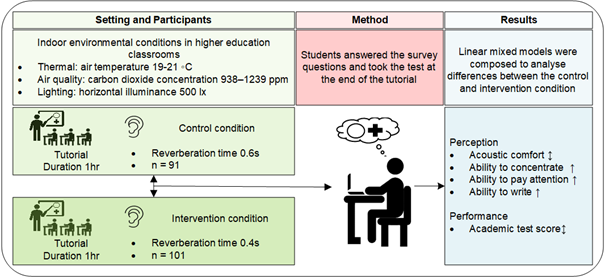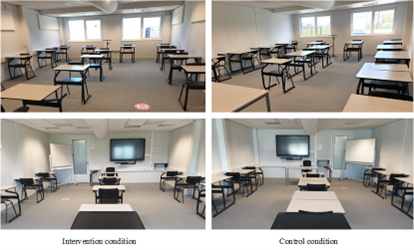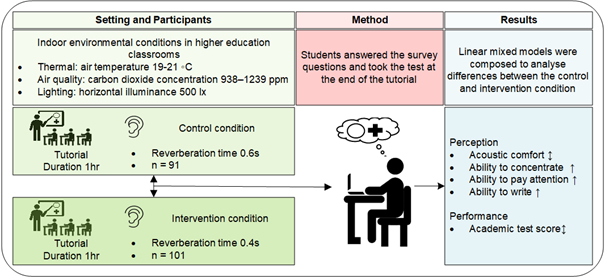
Research about the effect of reverberation time reduction on students and their performance was carried out by Henk W. Brink.

- Name: Henk W. Brink
- Where do you live: The Netherlands
- Company you work for: Hanze University of applied sciences
- Where do you go to find peace: the forest
- What’s your favourite sound: sounds of nature
- How did you end up working with acoustics: my interest in indoor environmental conditions
- What acoustics-related challenges do you face: creating optimal environmental conditions for students
- What is it like to work with room acoustics in your country: very promising and interesting because especially acoustic conditions are subject for research and discussion, as well in offices as in schools
- What trends do you see in room acoustics: more awareness of the influence of acoustics on human’s health, comfort and performance
Study Overview
This study explored an alteration of the classrooms’ reverberation time (RT). This lead to acoustic conditions meeting quality class A of Dutch guidelines, resulting in a positive effect on students’ perceptions and performance. A field study, with a between-group experimental design, was conducted during the academic course in 2020-2021.
To meet Dutch quality class A or B specifications, as specified in the Programme of Demands “Frisse Scholen’ (RVO, 2015), the RT was lowered in the intervention condition to 0.4 sec (control condition 0.6 sec) using 40mm “Class A” absorbing fully covering ceiling tiles, “Class A” wall absorbing panels, and extra bass panels, placed above the ceiling tiles. Figure 1 below, shows two pictures of the interior of both classrooms after adjusting the RT.

Figure 1 Visual appearance of the intervention and control condition classrooms interior. The top photos show the classrooms from the lecturer’s perspective, the bottom photos show the students’ perspective
What was measured in the study
During two classes, students’ perceptions of the acoustic environmental quality, cognitive performance, and quality of learning were measured at the end of each lecture using questionnaires. Students’ short-term academic performance was evaluated with a content-related test.
From 137 students, 194 responses were collected. ox and whisker plots were composed to visualize students’ scores on all items in both the intervention and control condition. In addition, Linear mixed models (LMMs) were constructed to determine whether students scored higher on perceived acoustic comfort and perceived cognitive responses and on an academic test in the intervention condition compared to students in the control condition.
Student responses were statistically corrected for the moderators age, gender, the distance of students to the lecturer, the estimated number of hours of sleep before participation, and room temperature at home.
Student Alertness and ability to concentrate are most apparent after intervention
Of the five items addressing perceived cognitive performance, students’ scored on two items significantly higher in the intervention condition: students’ perceived alertness (β= 0.6; t(183)=-2.843; p= .005) and students’ perceived ability to concentrate (β= 0.43; t(183)=-2.036; p= .043).
There was a gender effect: male students on average scored higher on their perceived alertness and their perceived ability to concentrate than female students (respectively β = 0.40; t(183)=-2.052; p= .042 and β = 0.45; t(183)=-2.319; p= .021).
Furthermore, on the three items addressing perceived quality of learning, on two items students scored significantly higher in the intervention conditions: students’ perceived ability to write (β= 0.47; t(183)=-2.182; p= .030) and perceived productivity (β= 0.40; t(183)=-1.987; p= .048). However, students’ scores on the content-related test in the intervention condition did not differ from those in the control condition
Even a small reduction in RT to meet the Class A guideline improves acoustic comfort and learning outcomes
Except for the RT, the acoustic conditions in the intervention and control conditions were similar. The relatively small improvement of the RT of -0.2 s, as prescribed by Dutch guidelines (RVO, 2015), led to higher scores on all six related items addressing acoustic comfort in the intervention condition; however, LMMs showed no significant differences between the control and intervention condition, including students’ perceived ability to hear the lecturer’s voice.
An explanation for the absence of this effect is that ambient noise was similar in the intervention and control condition. Earlier research revealed that ambient noise, rather than RT, was found the most significant factor in understanding speech, and that the most important parameter for speech intelligibility is the signal to noise ratio (Bradley et al., 1999). The reduction of the RT from 0.6 to 0.4s positively influenced students’ perceived alertness, ability to concentrate, ability to write, and productivity.
And although previous research revealed a relation between students’ perceived cognitive performance and content-related test scores (Brink et al., 2022), the results do not confirm this relation. A more extensive version of this research has been published in the scientific journal Science of the total Environment (Brink et al., 2023). Figure 2 presents the results of this study.

Figure 2 graphical abstract of the performed study
Presented and published:
Presented and published: HEALTHY BUILDINGS 2025 and ISIAQ INTERNATIONAL Regional Conference, Europe. 9 June 2025. Reykjavík, Iceland.
References
RVO. (2015). Programma van Eisen Frisse Scholen 2015. Assessed January 18, 2019
Bradley, J. S., Reich, R. D., & Norcross, S. G. (1999). On the combined effects of signal-to-noise ratio and room acoustics on speech intelligibility. The Journal of the Acoustical Society of America, 106(4), 1820-1828.
Brink, H. W., Loomans, M. G. L. C., Mobach, M. P., & Kort, H. S. M. (2022). A systematic approach to quantify the influence of indoor environmental parameters on students’ academic performance. Indoor Air, 32(10), e13116.
Brink, H. W., Krijnen, W. P., Loomans, M. G., Mobach, M. P., & Kort, H. S. (2023). Positive effects of indoor environmental conditions on students and their performance in higher education classrooms: A between-groups experiment. Science of the Total Environment, 869, 161813.

